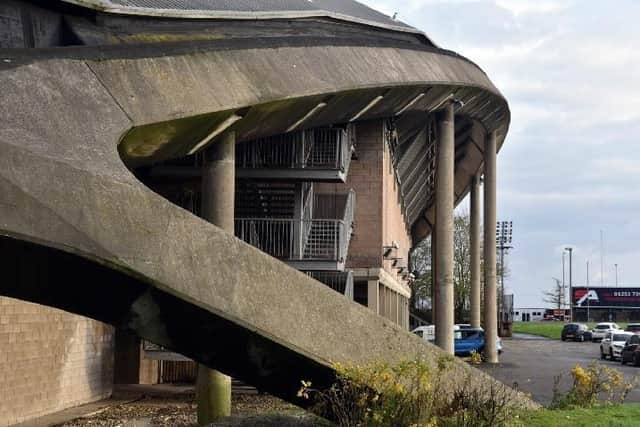Richard Dunn Sports Centre: Iconic building saved from demolition after being given Grade-II listed status
The heritage body has described the cavernous domed Richard Dunn Sports Centre in Bradford, which shut as a leisure centre in 2019, as a “bold and accomplished design for a 1970s local leisure centre".
The listing throws the future of the site into doubt, as it means the building is now among the most protected structures in the city. Built in 1974, it is one of the few post war buildings in the city to be awarded listed status.
Advertisement
Hide AdAdvertisement
Hide AdThe Twentieth Century Society, which campaigns for the preservation of buildings constructed after 1914, made a request to Historic England to have the building listed.


The organisation announced this week that the request had been successful, and it is now a Grade II listed building.
The Twentieth Century Society said the building, which was famous for its popular water slides, had a “bold architecture” and was one of the earliest buildings to be designed using computer technology.
Named after the Bradford-born boxer famed for fighting Muhammad Ali, the Richard Dunn Centre in Odsal shut its doors in November 2019 – coinciding with the opening of the nearby £17.5m Sedbergh Leisure Centre complex.
Advertisement
Hide AdAdvertisement
Hide AdThe original plans were for the demolition of Bradford Council-owned building to begin in early summer 2020. However, shortly after this announcement the Covid 19 pandemic began.
It was then that a new use was found for the building – a standby morgue should existing facilities in the district become overwhelmed.
Although this use was never needed, the site was put to use during the pandemic as a drive through Covid-19 testing centre and an “electrostatic biocide spraying station” for vehicles to be sanitised to prevent the spread of the virus.
The demolition had been repeatedly delayed since then, and the centre was used for filming last month. It is unclear what the future of the building will now be now it has a listed status.
Advertisement
Hide AdAdvertisement
Hide AdPermission to demolish Richard Dunn was granted in February 2020, and the council had said it was hugely ineffieicent to heat.
However, a listed status makes it difficult to gain permission to demolish a building. In recent years Bradford Council has refused planning permission for the demolition of a number of listed buildings, citing their historical significance.
Bradford Council had announced plans to redevelop the site once the building was demolished. Originally the plan was to sell the site, and in 2018 the authority began marketing the 6.8 hectare site as Odsal District Retail Centre in a brochure that was handed out to international developers at a real estate conference in Cannes.
But in early 2020 the council said it would keep the land, which it viewed as a “strategic site for the wider district.” The centre’s outdoor cycle track has been replaced by a new facility at the soon to open Wyke Sports Village.
Advertisement
Hide AdAdvertisement
Hide AdBefore listing the building, Historic England consulted Trevor Skempton, the architect who designed the leisure centre, and Dr Otto Saumarez Smith, an architectural history professor with expertise in leisure-centre history
They both praised the building, with Mr Skempton saying it was designed to have an “intentional theatrical aspect of the single open space, viewable from the access bridge, which enhanced the sporting experience.”
Bradford Council had written to Historic England to raise a number of issues with the building, including “high running costs when in use; a large maintenance backlog; a shortfall of the existing design against various current standards for access and energy efficiency; ongoing costs of mothballing the building; the budgetary assumption that capital receipts from sale of this site would contribute towards the cost of the replacement facilities; and the likely high costs should the building need to be reconnected to utilities.”
Summing up the listing, Historic England said: “The Richard Dunn Sports Centre is a bold and accomplished design for a 1970s local leisure centre. Its striking ‘big-top’, lattice-girder roof is of particular note.
Advertisement
Hide AdAdvertisement
Hide Ad“Conceived at a time when architectural expression for the building type was the exception rather than the rule, this example stands out within the national context, and has survived well, with its design intention entirely legible. Listing is therefore recommended at Grade II.”
It goes on to describe the building as “a sophisticated and architecturally striking structure which provided a dramatic setting for the sports provision within.”
It exhibits clear "engineering virtuosity” and “the principal features survive well with the general form and architectural intention remaining clear.”
A spokesperson for Bradford Civic Society said: “The decision to award listed status to Richard Dunn is an interesting and surprising one, especially given that permission had already been given for its demolition.
Advertisement
Hide AdAdvertisement
Hide Ad“It means Richard Dunn is now only one of a tiny minority of mid 20th Century listed buildings in Bradford, alongside Sunwin House.
“Bradford Civic Society has been increasingly vocal about the need to recognise the contribution made by 20th Century architecture in Bradford, as demonstrated through our debates on High Point and our upcoming event on post-war architecture in the city centre. There is certainly a growing appetite for such buildings.
“The decision is somewhat surprising given that Historic England rejected a similar application to list Arndale House on Market Street which, in the view of our experts, is a very compelling candidate for protected status.”
A spokesperson for Bradford Council said: “The Government decision that the former Richard Dunn Sports Centre should be Grade II listed has only just been published. We will need to look in detail at the report findings and work with the Government to see what the next steps are.”
